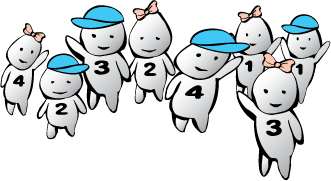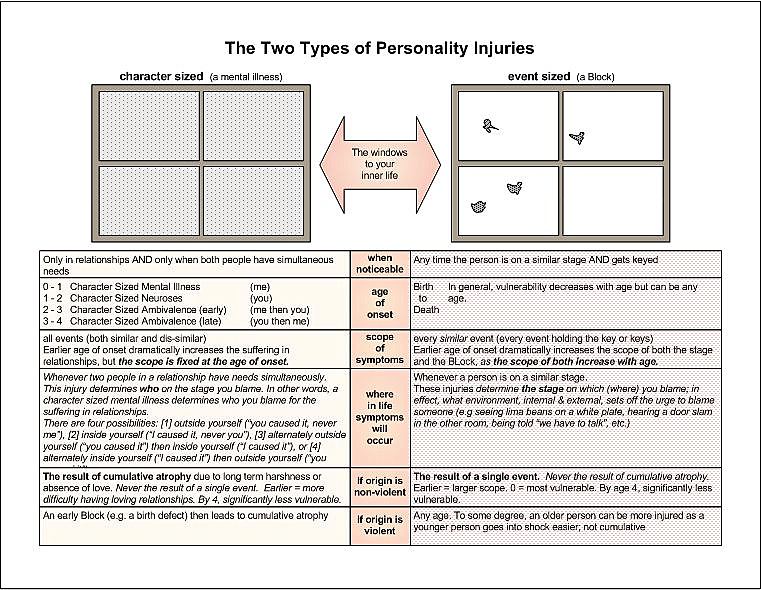 
Talk therapists practice under a lot of baggage. For more than a hundred years now, they have been pressured to conform to the accepted method for describing peoples' suffering; as some form of mental illness. Of course, until recently, to even suggest someone had some form of mental illness was like putting the kiss of death on the person, especially if it was a therapist making this determination. For this reason, I have never really liked describing peoples' suffering this way. Too cold. Too impersonal. Too harsh. Too medical. I am a therapist, though, and have been for some time now. And in order for people to get insurance reimbursements, I've had to conform to at least a token amount of this dehumanizing practice. Even so, I have long wished for a more humane and loving way to describe peoples' suffering. What follows is exactly that; essentially two generalized ways to describe the two forms of human suffering, both with a good amount of both theory and practice behind them. Why Two Types? Aren't All Personality Injuries the Same?What are these two forms? Character-Sized Mental Illnesses and BLocks. How are they different? Perhaps a metaphor would best describe them. Imagine you just bought a new house near a factory, one of those fume spewing monsters which still plague the Earth. You bought this house because you also have a big picture window overlooking a beautiful river, a river which is nestled between two high cliffs, with gnarled trees growing from them and big puffy clouds floating above them. The view is beautiful. Awesome, in fact. So much so, you bought the house despite the proximity to the factory. Now imagine a year has passed by. You look out the window realize the view has been partially obscured. Factory fumes have coated your window with soot. You can still see the beauty outside if you look, but the view is impaired. This is what getting a character-sized mental illness is like. It comes slowly. It accumulates gradually. And it affects everything the person sees, inside and out. And a BLock? Getting a BLock would be like you lived in this house and you got pranked at Halloween, such as if kids had thrown eggs at your picture window. Next day, parts of the view would be completely obscured, while most of the view would be fine. Still, those few spots would affect your whole ability to view. BLocks are like this, in that they come suddenly and violently. More so, the damage is done in one event, even though it is possible for repeated damage in the same spot to eventually enlarge the scope of this BLock a bit. How can this be true, that repeated recurrences only slightly enlarges the scope of the injury? Well, imagine the kids came back the very next night and through sheer luck, hit your window with eggs in the exact same places as they had hit it the night before. How much more of your view would be blocked? The point is, even if the egg was two inches thick in spots, if you were to be looking out the window from a few feet back, pretty much the same amount of your view would be blocked. Let me tell this another way. Suppose I was to tape a four inch circle of black paper over part of your car windshield, a bit to the right of where you look out. How much of your view would be blocked? Now imagine a past a second, identical sized piece of black paper over the first. How much more of your view would be blocked? And so on. In truth, then, just as the cliché says, the first cut is the deepest, in that fifteen pieces of black paper pasted in the same spot do not block much more of the view. This is how BLocks affect people. In fact, this is also one of the main things which makes them easier to heal than character sized mental illnesses; healing can be focused on any one of these similar events and still affect all the rest. How do these injuries actually affect people? Character-sized mental illnesses affect peoples' whole characters, everything they do, think, say, and feel. Mostly, though, they are visible only when the person is in a relationship and when both people have needs simultaneously. Other than in these times, most of the symptoms remain unseen. And BLocks? BLocks affect people only when they are on a stage similar enough to the original to be experienced as the same. Thus, BLocks remain hidden most of the time and only become visible in very specific circumstances. Also, they affect people in or out of relationships, with needs and without, only requiring the person be one a stage similar to the original one. What about the actual symptoms, the "symptoms" I've vaguely referred to twice. What do these symptoms look like? With character-sized mental illnesses, the symptoms all center around one effect: who gets blamed for the suffering. This is very different from BLocks in that BLocks determine when and where the suffering occurs. Let me say this once more: character-sized mental illnesses determine who gets blamed, and BLocks determine when and where someone gets blamed. Obviously, one of the first things to see is that these two kinds of injuries synergize and form very complex sets of symptoms, which is why trying the diagnose by symptoms alone is useless. More over, even with these two brief descriptions, one can easily see that injured people will often be symptom free, hardly conducive to judging whether someone's injury has healed or not. |
.